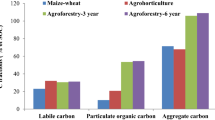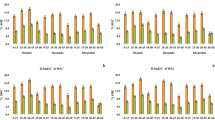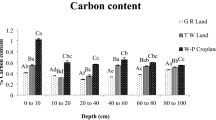Abstract
Soil organic carbon plays a major role in sustaining agroecosystems and maintaining environmental quality as it acts as a major source and sink of atmospheric carbon. The present study aims to assess the impact of agricultural management practices on soil organic carbon pools in a maize–wheat cropping system of Indo-Gangetic Plains, India. Soil samples from a split plot design with two tillage systems (bed planting and conventional tillage) and six nutrient treatments (T1 = control, T2 = 120 kg urea–N ha−1, T3 = T2 (25 % N substituted by FYM), T4 = T2 (25 % N substituted by sewage sludge), T5 = T2 + crop residue, T6 = 100 % organic source (50 % FYM + 25 % biofertilizer + 25 % crop residue) were used for determining the organic carbon pools. Results show that there was a significant improvement in Walkley and Black carbon in soil under integrated and organic nutrient management treatments. KMnO4-oxidizable carbon content of soil varied from 0.63 to 1.50 g kg−1 in soils and was found to be a better indicator for monitoring the impact of agricultural management practices on quality of soil organic carbon than microbial biomass carbon. Tillage and its interaction were found to significantly influence only those soil organic carbon fractions closely associated with aggregate stability viz, labile polysaccharides and glomalin. The highest amount of C4-derived carbon was found to be in plots receiving recommended doses of N as urea (29 %) followed by control plots (25 %). The carbon management index ranged between 82 to 195 and was better in integrated nutrient sources than ones receiving recommended doses of nutrients through mineral fertilizers alone.

Similar content being viewed by others
References
Aslam, J., Choudhary, M. A., & Saggar, S. (1999). Tillage impacts on soil microbial biomass C, N and P earthworms and agronomy after two years of cropping following permanent pasture in New Zealand. Soil & Tillage Research, 51, 103–111.
Banerjee, B., Aggarwal, P. K., Pathak, H., Singh, A. K., & Chaudhary, A. (2006). Dynamics of organic carbon and microbial biomass in alluvial soil with tillage and amendments in rice-wheat systems. Environmental Monitoring and Assessment, 119, 173–189.
Bayer, C., & Bertol, I. (1999). Características químicas de um cambissolo húmico afetadas por sistemas de preparo, com ênfase à matéria orgânica. Revista Brasileira de Ciência do Solo, 23, 687–694.
Bhattacharyya, P., Roy, K.S., Neogi, S., Adhya, T.K., Rao, K.S., & Manna, M.C. (2012a). Effects of rice straw and nitrogen fertilization on greenhouse gas emissions and carbon storage in tropical flooded soil planted with rice. Soil & Tillage Research, 124, 119–130.
Bhattacharyya, P., Roy, K. S., Neogi, S., Chakravorti, S. P., Behera, K. S., Das, K. M., Bardhan, S., & Rao, K. S. (2012b). Effect of long-term application of organic amendment on C storage in relation to global warming potential and biological activities in tropical flooded soil planted to rice. Nutrient Cycling in Agroecosystems, 94, 273–285.
Bhattacharyya, P., Sinhababu, D. P., Roy, K. S., Dash, P. K., Sahu, P. K., Dandapat, R., Neogi. S., & Mohanty, S. (2013). Effect of fish species on methane and nitrous oxide emission in relation to soil C, N pools and enzymatic activities in rainfed shallow lowland rice-fish farming system. Agriculture, Ecosystems and Environment, 176, 53– 62.
Bhogal, A., Nicholson, F. A., & Chambers, B. J. (2009). Organic carbon additions: effects on soil bio-physical and physio-chemical properties. European Journal of Soil Science, 60, 276–286.
Bird, M. I., & Pousai, P. (1997). Variations of δ13C in the surface soil organic carbon pool. Global Biogeochemical Cycles, 11, 313–322.
Blair, G. J., Lefroy, R. D. B., & Lisle, L. (1995). Soil carbon fractions based on their degree of oxidation, and the development of a carbon management index for agricultural systems. Australian Journal of Agricultural Research, 46, 1459–1466.
Bronick, C. J., & Lal, R. (2005). Soil structure and management: a review. Geoderma, 124, 3–22.
Burle, M. L., Mielniczuk, J., & Focchi, S. (1997). Effect of cropping systems on soil chemical characteristics, with emphasis on soil acidification. Plant and Soil, 190, 309–316.
Cernusak, L, A., Tcherkez, G., Keitel, C., Cornwell, W. K., Santiago, L. S., Knohl, A., Barbour, M. M., Williams, D. G., Reich, P. B., Ellsworth, D. S., Dawson, T. E., Griffiths, H. G., Farquhar, G. D., & Wright, I. J. (2009). Why are non-photosynthetic tissues generally 13C-enriched compared with leaves in C3 plants? Review and synthesis of current hypotheses. Functional Plant Biology, 36, 199–213.
Chan, K. Y. (1997). Consequences of changes in particulate organic matter in Vertisols under pasture and cropping. Soil Science Society of America Journal, 61, 1376–1382.
Chan, K. Y., & Heenan, D. P. (1996). The influence of crop rotation onsoil structure and soil physical properties under conventional tillage. Soil & Tillage Research, 37, 113–125.
Chen, Y., Zhang, X. D., He, H. B., Xie, H. T., Yan, Y., Zhu, P., Ren, J., & Wang, L. C. (2010). Carbon and nitrogen pools in different aggregates of a Chinese Mollisol as influenced by long-term fertilization. Journal of Soils and Sediments, 10, 1018–1026.
Cleveland, C. C., & Townsend, A. R. (2006). Nutrient additions to a tropical rain forest drive substantial soil carbon dioxide losses to the atmosphere. Proceedings of the National Academy of Sciences, 103, 10316–10321.
Cornejo, P., Rubio, R., & Borie, F. (2009). Mycorrhizal propagule persistence in a succession of cereals in a disturbed and undisturbed Andisol fertilized with two nitrogen sources. Chilean Journal of Agricultural Research, 69, 426–434.
Craine, J. M., Fierer, N., & Mclauchlan, K. K. (2010). Widespread coupling between the rate and temperature sensitivity of organic matter decay. Nature Geoscience, 3, 854–857.
Daniel, J., Davis, J., & Grant, L. (2002). Organic Farming Research Foundation Project Report, #00–49: Long-term organic farming impacts on soil fertility.
Davidson, E. A., & Janssens, I. A. (2006). Temperature sensitivity of soil carbon decomposition and feedbacks to climate change. Nature, 440, 165–173.
Duxbury, J. M., Abrol, I. P., Gupta, R. K., & Bronson, K. F. (2000). Analysis of long-term soil fertility experiments with rice–wheat rotations in South Asia. In I. P. Abrol, K. F. Bronson, J. M. Duxbury, & R. K. Gupta (Eds.), Long-term soil fertility experiments with rice–wheat rotations in South Asia (Rice–wheat consortium paper series, Vol. 6, pp. 7–22). New Delhi: Rice–Wheat Consortium for the Indo-Gangetic Plains.
Fontaine, S., & Barot, S. (2005). Size and functional diversity of microbe populations control plant persistence and long-term soil carbon accumulation. Ecology Letters, 8, 1075–1087.
Fontaine, S., Barot, S., Barre, P., Bdioui, N., Mary, B., & Rumpel, C. (2007). Stability of organic carbon in deep soil layers controlled by fresh carbon supply. Nature, 450, 277–280.
Ghoshal, N., & Singh, K. P. (1995). Effects of farmyard manure and inorganic fertilizers on the dynamics of soil microbial biomass in a tropical dryland agroecosystem. Biology and Fertility of Soils, 19, 231–238.
Gomez, A. A., & Gomez, A. K. (1984). Statistical procedures for agricultural research (2nd ed., pp. 180–209). New York: Wiley.
Goswami, N.N. (2006). Soil and its quality vis–a–vis sustainability and society: some random thoughts. In: Proceedings of International Conference on Soil, Water and Environmental – Issues and Strategies (pp. 43–58), New Delhi: Indian Society of Soil Science.
Graham, M. H., Haynes, R. J., & Meyer, J. H. (2002). Soil organic matter content and quality: effects of fertilizer applications, burning and retention on a long term sugarcane experiment in South Africa. Soil Biology and Biochemistry, 34, 93–102.
Gupta, R. K. (2003). The rice–wheat consortium for the Indo-Gangetic Plains: vision and management structure. In: addressing resource conservation issues in rice–wheat systems for South Asia: a resource book (pp. 1–7). New Delhi: Rice Wheat Consortium-CIMMYT.
Haynes, R. J. (2005). Labile organic matter fractions as central components of the quality of agricultural soils: an overview. Advances in Agronomy, 85, 221–268.
Haynes, R. J., Swift, R. J., & Stephen, R. C. (1991). Influence of mixed cropping rotations (pasture-arable) on organic matter content water stable aggregation and clod porosity in a group of soils. Soil & Tillage Research, 19, 77–87.
Hermle, S., Anken, T., Leifeld, J., & Weisskopf, P. (2008). The effect of the tillage system on soil organic carbon content under moist, cold-temperate conditions. Soil & Tillage Research, 98, 94–105.
Hooker, B. A., Morris, T. F., Peters, R., & Cardon, Z. G. (2005). Long-term effects of tillage and corn stalk return on soil carbon dynamics. Soil Science Society of America Journal, 69, 188–196.
Jarecki, M. K., & Lal, R. (2003). Crop management for soil carbon sequestration. Critical Reviews in Plant Sciences, 22, 471–502.
Jenkinson, D. S., & Powlson, D. S. (1976). The effects of biological treatments on metabolism in soil. V. A method for measuring soil biomass. Soil Biology and Biochemistry, 8, 209–213.
John, B., Yamashita, T., Ludwig, B., & Flessa, H. (2005). Storage of organic carbon in aggregate and density fractions of silty soils under different types of land use. Geoderma, 128, 38–79.
Katyal, J. C., Rao, N. H., & Reddy, M. N. (2001). Critical aspects of organic matter management in the tropics: the example of India. Nutrient Cycling in Agroecosystems, 61, 77–88.
Kuzyakov, Y., & Domanski, G. (2000). Carbon input by plants into soil—review. Journal of Soil Science and Plant Nutrition, 163, 421–431.
Ladha, J. K., Dawe, D., Pathak, H., Padre, A. T., Yadav, R. L., Singh, B., Singh, Y., Singh, Y., Singh, P., Kundu, A. L., Sakal, R., Ram, N., Regmi, A. P., Gami, S. K., Bhandari, A. L., Amin, R., Yadav, C. R., Bhattarai, E. M., Das, S., Aggarwal, H. P., Gupta, R. K., & Hobbs, P. R. (2003). How extensive are yield declines in long-term rice–wheat experiments in Asia? Field Crops Research, 81, 159–180.
Lal, R. (2004). Soil carbon sequestration impacts on global climate change and food security. Science, 304, 1623–1627.
Lal, R., Follett, F., Stewart, B. A., & Kimble, J. M. (2007). Soil carbon sequestration to mitigate climate change and advance food security. Soil Science, 172, 943–956.
Leite, L. F. C., Mendonga, E. S., & Machado, P. L. O. A. (2007). Influence of organic and mineral fertilization on organic matter fractions of a Brazilian Acrisol under maize/common bean intercrop. Australian Journal of Soil Research, 45, 25–32.
Lowe, L. E. (1994). Total and labile acid extractable polysaccharide analysis of soils. In M. R. Carter (Ed.), Soil sampling and methods of analysis (pp. 373–376). Boca Raton: Lewis Publishers.
Majumder, B., Mandal, B., & Bandyopadhyay, P. K. (2008). Soil organic carbon pools and productivity in relation to nutrient management in a 20-year-old riceberseem agroecosystem. Biology and Fertility of Soils, 44, 451–561.
Martín, A., Diaz-Raviña, M., & Carballas, T. (2011). Seasonal changes in the carbohydrate pool of an Atlantic forest soil under different vegetation types. Spanish Journal of Soil Science, 1, 38–53.
McDonagh, J. F., Thomsen, T. B., & Magid, J. (2001). Soil organic matter decline and compositional change associated with cereal cropping in southern Tanzania. Land Degradation and Development, 12, 13–26.
Mikha, M. M., & Rice, C. W. (2004). Tillage and manure effects on soil and aggregate associated carbon and nitrogen. Soil Science Society of America Journal, 68, 809–816.
Mtambanengwe, F., & Mapfumo, P. (2008). Smallholder farmer management impacts on particulate and labile carbon fractions of granitic sandy soils in Zimbabwe. Nutrient Cycling in Agroecosystems, 81, 1–15.
Nohrstedt, H. O., Arnebrant, K., Baath, E., & Soderstorm, E. (1989). Changes in carbon content, respiration rate ATP content and microbial biomass in nitrogen fertilized pine forest soils in Sweden. Canadian Journal of Forest Research, 23, 1275–1285.
Rudrappa, L., Purakayastha, T. J., Singh, D., & Bhararay, S. (2006). Long-term manuring and fertilization effects on soil organic carbon pools in a Typic Haplustept of semi-arid sub-tropical India. Soil & Tillage Research, 88, 180–192.
Ryan, M. C., Aravena, R., & Gillham, R. W. (1995). The use of 13C natural abundance to investigate the turnover of the microbial biomass and active fractions of soil organic matter under two tillage treatments. In R. Lal, J. Kimble, E. Levine, & B. A. Stewart (Eds.), Soils and global change (pp. 351–360). Boca Raton: CRC Press.
Sandeep, S., & Manjaiah, K. M. (2014). Thermal stability of organic carbon in soil aggregates of maize–wheat system in semi arid India. Journal of Soil Science and Plant Nutrition, 14, 625–639.
Shrestha, R. K., Lal, R., & Jacinthe, P. A. (2009). Enhancing carbon and nitrogen sequestration of reclaimed mine soils in Ohio by using organic amendments and chiselling. Soil Science Society of America Journal, 73, 1004–1011.
Singh, G. R., Pandya, K. S., Chaure, N. K., Parihar, S. S., & Choudhary, K. (2000). Soil fertility, productivity and profitability of rice under different organic manures. Oryza, 37, 208–212.
Skjemstad, J. O., Swift, R. S., & McGown, J. A. (2006). Comparison of the particulate organic carbon and permanganate oxidation methods for estimating labile soil organic carbon. Australian Journal of Soil Research, 44, 255–263.
Still, C. J., Berry, J. A., Collatz, J. G., & DeFries, R. S. (2003). Global distribution of C3 and C4 vegetation: carbon cycle implications. Global Biogeochemical Cycles, 17, 1–6.
Tian, G., Kang, B. T., & Brussaard, T. (1992). Biological effects of plant residues with contrasting chemical compositions under humid tropical conditions: decomposition and nutrient release. Soil Biology & Biochemistry, 24, 1051–1060.
Valzano, F., Murphy, B. W., & Koen, T. (2005). The impact of tillage on changes in soil carbon density with special emphasis on Australian conditions. Canberra: National Carbon Accounting System, Australian Greenhouse Office.
Vanhala, P., Karhu, K., Tuomi, M., Sonninenb, E., Jungnerb, H., Fritzec, H., & Liskia, J. (2007). Old soil carbon is more temperature sensitive than the young in an agricultural field. Soil Biology & Biochemistry, 39, 2967–2970.
Verma, B. C., Datta, S. P., Rattan, R. K., & Singh, A. K. (2010). Monitoring changes in soil organic carbon pools, nitrogen, phosphorus, and sulfur under different agricultural management practices in the tropics. Environmental Monitoring and Assessment, 171, 579–593.
Villegas-Pangga, G., Blair, G. J., & Lefroy, R. (2000). Measurement of decomposition and associated nutrient release from straw (Oriza sativa L.) of different rice varieties using a perfusion system. Plant and Soil, 233, 1–11.
Walkley, A., & Black, I. A. (1934). An examination of the Degtjareff method for determining soil organic matter and a proposed modification of the chromic acid titration method. Soil Science, 37, 29–38.
West, T. O., & Post, W. M. (2002). Soil organic carbon sequestration rates by tillage and crop rotation: a global data analysis. Soil Science Society of America Journal, 66, 1930–1946.
Whistler, R. L., Wolfrom, M. L., & BeMiller, J. N. (1962). Methods in carbohydrate chemistry. New York: Academic Press.
Wright, S. F., & Upadhyaya, A. (1998). A survey of soils for aggregate stability and glomalin, a glycoproteins produced by hyphae of arbuscular mycorrhizal fungi. Plant and Soil, 198, 97–107.
Wright, S. F., & Upadhyaya, A. (1999). Quantification of arbuscular mycorrhizal fungi activity by the glomalin concentration on hyphal traps. Mycorrhiza, 8, 283–285.
Wright, S. F., Franke-Snyder, M., Morton, J. B., & Upadhyaya, A. (1996). Time-course study and partial characterization of a protein on hyphae of arbuscular mycorrhizal fungi during active colonization of roots. Plant and Soil, 181, 193–203.
Wynn, J. G., & Bird, M. (2007). C4-derived soil organic carbon decomposes faster than its C3 counterpart in mixed C3/C4 soils. Global Change Biology, 13, 1–12.
Yuan, Y., Han, X., Li, L., & Li, N. (2012). Land use effects on soil aggregation and total organic carbon and polysaccharides in aggregates of a Chinese Mollisol. Journal of Food, Agriculture and Environment, 10, 1386–1391.
Zheng, Z. C., He, S. Q., Li, T. X., & Wang, Y. D. (2011). Effect of land use patterns on stability and distributions of organic carbon in the hilly region of Western Sichuan, China. African Journal of Biotechnology, 10, 13107–13114.
Acknowledgments
The authors thank the Head of the Division of Soil Science and Agricultural Chemistry, Indian Agricultural Research Institute, New Delhi for providing facilities for the successful completion of the research work.
Author information
Authors and Affiliations
Corresponding author
Rights and permissions
About this article
Cite this article
Sandeep, S., Manjaiah, K.M., Pal, S. et al. Soil carbon fractions under maize–wheat system: effect of tillage and nutrient management. Environ Monit Assess 188, 14 (2016). https://doi.org/10.1007/s10661-015-4995-3
Received:
Accepted:
Published:
DOI: https://doi.org/10.1007/s10661-015-4995-3




